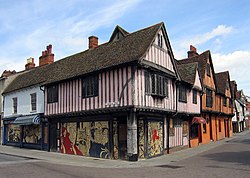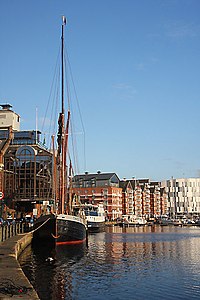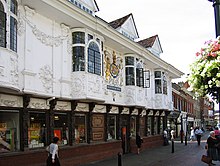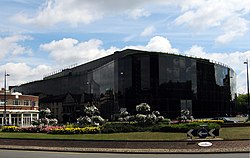Ipswich: Difference between revisions
Created page with '{{Infobox town |name=Ipswich |county=Suffolk |picture=Ipswich St Nicholas St.jpg |picture caption=St Nicholas Street, Ipswich |os grid ref=TM162445 |latitude= 52.056925 |longitud…' |
mNo edit summary |
||
| (3 intermediate revisions by 3 users not shown) | |||
| Line 7: | Line 7: | ||
|latitude= 52.056925 | |latitude= 52.056925 | ||
|longitude=1.153062 | |longitude=1.153062 | ||
|postcode= | |post town=Ipswich | ||
|postcode=IP | |||
|dialling code=01473 | |dialling code=01473 | ||
|LG district=Ipswich | |LG district=Ipswich | ||
|constituency= | |constituency= | ||
}} | }} | ||
'''Ipswich''' is a large port town in [[Suffolk]], standing on the estuary of the [[River Orwell]]. A little downstream is the complementary port of [[Felixstowe]]. Inland are [[Needham Market]] and [[Stowmarket]] in Suffolk and | '''Ipswich''' is a large port town in [[Suffolk]], standing on the estuary of the [[River Orwell]]. A little downstream is the complementary port of [[Felixstowe]]. Inland are [[Needham Market]] and [[Stowmarket]] in Suffolk and nearby [[Harwich]] and [[Colchester]] in [[Essex]]. | ||
Ipswich has been a major port since Anglo-Saxon times and perhaps earlier; one of the few such to remain an important port to this day. It was known in those days as ''Gipeswic'', | Ipswich has been a major port since Anglo-Saxon times and perhaps earlier; one of the few such to remain an important port to this day. It was known in those days as ''Gipeswic'', a name seeming to have a common origin with the River Gipping which is the non-tidal section of the River Orwell. | ||
Ipswich today consists of a fine historic core with | Ipswich today consists of a fine historic core with mediæval and Tudor merchants' buildings, surrounded by incongruent modern suburbs. | ||
==History== | ==History== | ||
| Line 22: | Line 23: | ||
A large Roman fort, part of the coast defences of Britain, stood at [[Walton, Suffolk|Walton]] near [[Felixstowe]] (13 miles away),<ref>J. Fairclough and S. J. Plunkett, 'Drawings of Walton Castle and other Monuments in Walton and Felixstowe', ''Proceedings of the Suffolk Institute of Archaeology and History'' 39 Part 4, 419–459. See also J. Fairclough, ''Boudica to Raedwald: East Anglia's Relations with Rome'' (Malthouse Press, Ipswich 2010), 174–77.</ref> and the largest Roman villa in Suffolk stood at Castle Hill in north-western Ipswich.<ref>The so-called 'Whitton' villa, see J. Fairclough, 'Boudica to Raedwald' (cited above), 134–145.</ref> | A large Roman fort, part of the coast defences of Britain, stood at [[Walton, Suffolk|Walton]] near [[Felixstowe]] (13 miles away),<ref>J. Fairclough and S. J. Plunkett, 'Drawings of Walton Castle and other Monuments in Walton and Felixstowe', ''Proceedings of the Suffolk Institute of Archaeology and History'' 39 Part 4, 419–459. See also J. Fairclough, ''Boudica to Raedwald: East Anglia's Relations with Rome'' (Malthouse Press, Ipswich 2010), 174–77.</ref> and the largest Roman villa in Suffolk stood at Castle Hill in north-western Ipswich.<ref>The so-called 'Whitton' villa, see J. Fairclough, 'Boudica to Raedwald' (cited above), 134–145.</ref> | ||
Ipswich is one of Britain's oldest towns,<ref>{{cite web | title=History of Mediæval Ipswich | url=http://www.trytel.com/~tristan/towns/ipswich1.html | accessdate=13 June 2007}}</ref><ref>{{cite web | title=History of Mediæval Ipswich | url=http://www.historyfiles.co.uk/FeaturesBritain/EnglandOldestTown.htm | | Ipswich is one of Britain's oldest towns,<ref>{{cite web | title=History of Mediæval Ipswich | url=http://www.trytel.com/~tristan/towns/ipswich1.html | accessdate=13 June 2007}}</ref><ref>{{cite web | title=History of Mediæval Ipswich | url=http://www.historyfiles.co.uk/FeaturesBritain/EnglandOldestTown.htm | | accessdate=27 June 2007}}</ref> and took shape in Anglo-Saxon times around Ipswich dock. As the coastal states of north-western Europe emerged from the collapse of the Roman Empire, essential North Sea trade and communication between eastern Britain and the continent (especially to Scandinavia, and through the Rhine) passed through the formerly Roman ports of [[London]] and of [[York]]. | ||
Ipswich arose as the | Ipswich arose as a commercial port for the Kingdom of [[East Anglia]],<ref>K. Wade, 'Gipeswic – East Anglia's first economic capital, 600–1066', in N. Salmon and R. Malster (eds), ''Ipswich From The First To The Third Millennium'' (Ipswich, 2001), 1–6; R. Hodges, ''Dark Age Economics: The Origins of Town and Trade AD 600–1000'' (London 1982); S. Plunkett, ''Suffolk in Anglo-Saxon Times'' (Tempus, Stroud 2005), 76–78, 129–133, 148–52, 156–58, 200–202; Rhodri Gardner, 'Ipswich, Cranfield's Mill', in 'Archaeology in Suffolk 2005', ''Proceedings of the Suffolk Institute of Archaeology and History'' 41 Part 2, 2006, p.251; A. E. Verhulst, ''The Rise of Cities in North-Western Europe'' (Cambridge University Press 1999), pp. 27–30; R. Malster, ''A History of Ipswich'' (Phillimore, Chichester 2000), pp. 5–13.</ref> its early imported wares dating to the time of King Rædwald, supreme ruler of the English (616–624). The Ipswich Museum houses replicas of the Roman Mildenhall Treasure and the Sutton Hoo treasure, the latter taken from the ship burial believed to be Rædwald's grave. | ||
The 7th century town was centred near the quay. Towards 700, Frisian potters from the Netherlands area settled in Ipswich and set up the first large-scale potteries in England since Roman times. Their wares were traded far across England, and the industry was unique to Ipswich for 200 years.<ref>K. Wade, 'Gipeswic – East Anglia's First Economic Capital 600–1066,' in N. P. Salmon and R. Malster (Eds), ''Ipswich From the First to the Third Millennium'' (Papers from an Ipswich Society Symposium), (Ipswich Society, Ipswich 2001), 1–6, at pp. 3–4.</ref><ref>S. J. Plunkett, ''Suffolk in Anglo-Saxon Times'' (Tempus, Stroud 2005), 130–133, 201.</ref> With growing prosperity, in about 720 | The 7th century town was centred near the quay. Towards 700, Frisian potters from the Netherlands area settled in Ipswich and set up the first large-scale potteries in England since Roman times. Their wares were traded far across England, and the industry was unique to Ipswich for 200 years.<ref>K. Wade, 'Gipeswic – East Anglia's First Economic Capital 600–1066,' in N. P. Salmon and R. Malster (Eds), ''Ipswich From the First to the Third Millennium'' (Papers from an Ipswich Society Symposium), (Ipswich Society, Ipswich 2001), 1–6, at pp. 3–4.</ref><ref>S. J. Plunkett, ''Suffolk in Anglo-Saxon Times'' (Tempus, Stroud 2005), 130–133, 201.</ref> With growing prosperity, in about AD 720 a large new part of the town was laid out in the Buttermarket area. Ipswich was becoming a place of national and international importance.<ref>Wade 2001.</ref> Parts of the ancient road plan still survive in its modern streets. | ||
The Danes invaded in 869, and Ipswich fell under their rule. The earth ramparts circling the town centre were probably raised by Danes in Ipswich around 900 to prevent its recapture by the English,<ref>Wade 2001, 5.</ref><ref>R. Malster, ''A History of Ipswich'' (Phillimore, Chichester 2000), 13.</ref> though the town soon fell to King Edmund. Ipswich had a mint under royal licence from King Edgar I in the 970s, which continued through the Norman Conquest until the time of King John, in about 1215.<ref>J. J. North, ''English Hammered Coinage'' (Spink and Son, London 1980), ''Volume I: Early Anglo-Saxon to Henry III'', 'Mint Towns' (page 194), Ipswich, Suffolk: Edgar to John. Example figure:Aethelred II first hand type, Plate X no. 23, Cat. 766 & p. 120.</ref> The abbreviation 'Gipes' appears on the coins. | The Danes invaded in 869, and Ipswich fell under their rule. The earth ramparts circling the town centre were probably raised by Danes in Ipswich around 900 to prevent its recapture by the English,<ref>Wade 2001, 5.</ref><ref>R. Malster, ''A History of Ipswich'' (Phillimore, Chichester 2000), 13.</ref> though the town soon fell to King Edmund. Ipswich had a mint under royal licence from King Edgar I in the 970s, which continued through the Norman Conquest until the time of King John, in about 1215.<ref>J. J. North, ''English Hammered Coinage'' (Spink and Son, London 1980), ''Volume I: Early Anglo-Saxon to Henry III'', 'Mint Towns' (page 194), Ipswich, Suffolk: Edgar to John. Example figure:Aethelred II first hand type, Plate X no. 23, Cat. 766 & p. 120.</ref> The abbreviation 'Gipes' appears on the coins. | ||
| Line 66: | Line 67: | ||
*Theatres: | *Theatres: | ||
**New Wolsey Theatre: a 400 seat theatre on Civic Drive | **New Wolsey Theatre: a 400-seat theatre on Civic Drive | ||
**The [http://www.easternangles.co.uk Eastern Angles] theatre group based at the Sir [[John Mills]] Theatre | **The [http://www.easternangles.co.uk Eastern Angles] theatre group based at the Sir [[John Mills]] Theatre | ||
*''Ip-Art'' [http://www.ip-art.com/] brings many events together across art disciplines and different venues, notably a free music day in Christchurch Park, which in 2006 had over 50 different acts performing over 7 stages. | *''Ip-Art'' [http://www.ip-art.com/] brings many events together across art disciplines and different venues, notably a free music day in Christchurch Park, which in 2006 had over 50 different acts performing over 7 stages. | ||
| Line 80: | Line 81: | ||
==Outside links== | ==Outside links== | ||
{{Commons | {{Commons}} | ||
*[http://www.ipswichsociety.org.uk/ The Ipswich Society] | *[http://www.ipswichsociety.org.uk/ The Ipswich Society] | ||
*[http://ipswichinstitute.org.uk/ Ipswich Institute Reading Room and Library] | *[http://ipswichinstitute.org.uk/ Ipswich Institute Reading Room and Library] | ||
Latest revision as of 20:32, 22 September 2018
| Ipswich | |
| Suffolk | |
|---|---|
 St Nicholas Street, Ipswich | |
| Location | |
| Grid reference: | TM162445 |
| Location: | 52°3’25"N, 1°9’11"E |
| Data | |
| Post town: | Ipswich |
| Postcode: | IP |
| Dialling code: | 01473 |
| Local Government | |
| Council: | Ipswich |
Ipswich is a large port town in Suffolk, standing on the estuary of the River Orwell. A little downstream is the complementary port of Felixstowe. Inland are Needham Market and Stowmarket in Suffolk and nearby Harwich and Colchester in Essex.
Ipswich has been a major port since Anglo-Saxon times and perhaps earlier; one of the few such to remain an important port to this day. It was known in those days as Gipeswic, a name seeming to have a common origin with the River Gipping which is the non-tidal section of the River Orwell.
Ipswich today consists of a fine historic core with mediæval and Tudor merchants' buildings, surrounded by incongruent modern suburbs.
History

A large Roman fort, part of the coast defences of Britain, stood at Walton near Felixstowe (13 miles away),[1] and the largest Roman villa in Suffolk stood at Castle Hill in north-western Ipswich.[2]
Ipswich is one of Britain's oldest towns,[3][4] and took shape in Anglo-Saxon times around Ipswich dock. As the coastal states of north-western Europe emerged from the collapse of the Roman Empire, essential North Sea trade and communication between eastern Britain and the continent (especially to Scandinavia, and through the Rhine) passed through the formerly Roman ports of London and of York.
Ipswich arose as a commercial port for the Kingdom of East Anglia,[5] its early imported wares dating to the time of King Rædwald, supreme ruler of the English (616–624). The Ipswich Museum houses replicas of the Roman Mildenhall Treasure and the Sutton Hoo treasure, the latter taken from the ship burial believed to be Rædwald's grave.
The 7th century town was centred near the quay. Towards 700, Frisian potters from the Netherlands area settled in Ipswich and set up the first large-scale potteries in England since Roman times. Their wares were traded far across England, and the industry was unique to Ipswich for 200 years.[6][7] With growing prosperity, in about AD 720 a large new part of the town was laid out in the Buttermarket area. Ipswich was becoming a place of national and international importance.[8] Parts of the ancient road plan still survive in its modern streets.
The Danes invaded in 869, and Ipswich fell under their rule. The earth ramparts circling the town centre were probably raised by Danes in Ipswich around 900 to prevent its recapture by the English,[9][10] though the town soon fell to King Edmund. Ipswich had a mint under royal licence from King Edgar I in the 970s, which continued through the Norman Conquest until the time of King John, in about 1215.[11] The abbreviation 'Gipes' appears on the coins.
King John granted the town its first charter in 1200, laying the mediæval foundations of its modern civil government.[12][13] In the next four centuries it made the most of its wealth, trading Suffolk cloth with Europe. Around 1380, Geoffrey Chaucer satirised the merchants of Ipswich in the Canterbury Tales. Ipswich was a kontor for the Hanseatic League with its port used for import and export to the Baltic.
During the Middle Ages the town had five large religious houses, including two Augustinian Priories (St Peter and St Paul, and Holy Trinity, both mid-12th century[14]), and those of the Greyfriars (Franciscans, before 1298), Ipswich Whitefriars (Carmelites founded 1278–79) and Blackfriars (Dominicans, before 1263), stood in mediæval Ipswich. The last Carmelite Prior of Ipswich was the celebrated John Bale, author of the oldest English historical verse-drama (Kynge Johan, c.1538).[15] There were also several hospitals, including the leper hospital of St Mary Magdalene, founded before 1199. The Shrine of Our Lady of Grace was a famous place of pilgrimage; King Henry VIII and Katherine of Aragon visited it.[16][17] At the Reformation, the shrine was demolished and the idol was taken away to London to be burned.
Thomas Wolsey, the future cardinal, was born in Ipswich about 1475 as the son of a wealthy landowner. One of Henry VIII's closest political allies, he founded a college in the town in 1528, which was for its brief duration one of the homes of the Ipswich School.[18] He remains one of the town's most famed figures.

In the time of Queen Mary I the Ipswich Martyrs were burnt at the stake on the Cornhill for their Protestant beliefs. A monument commemorating this event now stands in Christchurch Park. From 1611 to 1634 Ipswich was a major centre for emigration to New England. This was encouraged by the Town Lecturer, Samuel Ward. His brother Nathaniel Ward was first minister of Ipswich, Massachusetts, where a promontory was named 'Castle Hill' after the place of that name in north-western Ipswich. Ipswich was also one of the main ports of embarkation for puritans leaving other East Anglian towns and villages for the Massachusetts Bay Colony during the 1630s and what has become known as the Great Migration.[19]
The painter Thomas Gainsborough lived and worked in Ipswich. In 1835, Charles Dickens stayed in Ipswich and used it as a setting for scenes in his novel The Pickwick Papers. The hotel where he resided first opened in 1518; it was then known as The Tavern and is now known as the Great White Horse Hotel. Dickens made the hotel famous in chapter XXI of The Pickwick Papers, vividly describing the hotel's meandering corridors and stairs.
In 1824, Dr George Birkbeck, with support from several local businessmen, founded one of the first Mechanics' Institutes which survives to this day as the independent Ipswich Institute Reading Room and Library. The elegant 15 Tavern Street building has been the site of the Library since 1836.
In 1797 Lord and Lady Nelson moved to Ipswich, and in 1800 Lord Nelson was appointed High Steward of Ipswich.
In the mid-19th century Coprolite (fossilized animal dung) was discovered, the material was mined and then dissolved in acid, the resulting mixture forming the basis of Fisons fertilizer business.[20]
Ipswich was subject to bombing by German Zeppelins during the First World War but the greatest damage by far occurred during the German bombing raids of Second World War. The area in and around the docks were especially devastated. The last bombs to fall on Ipswich landed on Seymour Street in March 1945.[21]
Modern Ipswich
Ipswich has undergone an extensive rebuilding and a gentrification programme in recent years, principally centred around the waterfront. Though this has turned a former industrial dock area into an emerging residential and commercial centre, it is being completed at the expense of much of the town's industrial and maritime heritage and in spite of efforts made by the Ipswich Society. Much of this development is residential and is marketed at high net-worth individuals.
Culture

- Art galleries are found in:
- Christchurch Mansion
- The Town Hall
- Ancient House
- Artists Gallery in Electric House
- Museums include:
- Ipswich Museum
- Ipswich Transport Museum
Performing arts are well represented with Ipswich being home to many cultural hubs.
- Theatres:
- New Wolsey Theatre: a 400-seat theatre on Civic Drive
- The Eastern Angles theatre group based at the Sir John Mills Theatre
- Ip-Art [1] brings many events together across art disciplines and different venues, notably a free music day in Christchurch Park, which in 2006 had over 50 different acts performing over 7 stages.
- Key Arts is an artist run space using the redundant St Mary at the Quay Church on the waterfront. They hold a comprehensive programme of events and residencies during the year and have been running since 2006.
Popular culture
- In the original version of Monty Python's famous Dead Parrot sketch Michael Palin's character claims that Ipswich is the palindrome of Bolton.
- Ipswich was the base of operations for Russian illegal agent Valeri Petrofsky in the Frederick Forsyth novel, The Fourth Protocol (and the later film based on the novel).
- Michael Palin's 1987 comedy about provincial English seaside holidays in the 1950s was entitled East of Ipswich.
- In Stardust (2007 film), Ipswich is mentioned at the beginning of the movie when Sienna Miller as Victoria says of her fiancé, "I can't exactly say no, after he's gone all the way to Ipswich!".
- In the Doctor Who episode "The End of the World" after the Doctor tells her to stay where she is Rose Tyler says "where am I gonna go, Ipswich?"
- Matthew Freeman from Anthony Horowitz's novels The Power of Five is sent to Ipswich after the death of his parents
Outside links
| ("Wikimedia Commons" has material about Ipswich) |
- The Ipswich Society
- Ipswich Institute Reading Room and Library
- Mediæval town plan of Ipswich Town
- Ipswich Borough Council
References
- ↑ J. Fairclough and S. J. Plunkett, 'Drawings of Walton Castle and other Monuments in Walton and Felixstowe', Proceedings of the Suffolk Institute of Archaeology and History 39 Part 4, 419–459. See also J. Fairclough, Boudica to Raedwald: East Anglia's Relations with Rome (Malthouse Press, Ipswich 2010), 174–77.
- ↑ The so-called 'Whitton' villa, see J. Fairclough, 'Boudica to Raedwald' (cited above), 134–145.
- ↑ "History of Mediæval Ipswich". http://www.trytel.com/~tristan/towns/ipswich1.html. Retrieved 13 June 2007.
- ↑ "History of Mediæval Ipswich". http://www.historyfiles.co.uk/FeaturesBritain/EnglandOldestTown.htm. Retrieved 27 June 2007.
- ↑ K. Wade, 'Gipeswic – East Anglia's first economic capital, 600–1066', in N. Salmon and R. Malster (eds), Ipswich From The First To The Third Millennium (Ipswich, 2001), 1–6; R. Hodges, Dark Age Economics: The Origins of Town and Trade AD 600–1000 (London 1982); S. Plunkett, Suffolk in Anglo-Saxon Times (Tempus, Stroud 2005), 76–78, 129–133, 148–52, 156–58, 200–202; Rhodri Gardner, 'Ipswich, Cranfield's Mill', in 'Archaeology in Suffolk 2005', Proceedings of the Suffolk Institute of Archaeology and History 41 Part 2, 2006, p.251; A. E. Verhulst, The Rise of Cities in North-Western Europe (Cambridge University Press 1999), pp. 27–30; R. Malster, A History of Ipswich (Phillimore, Chichester 2000), pp. 5–13.
- ↑ K. Wade, 'Gipeswic – East Anglia's First Economic Capital 600–1066,' in N. P. Salmon and R. Malster (Eds), Ipswich From the First to the Third Millennium (Papers from an Ipswich Society Symposium), (Ipswich Society, Ipswich 2001), 1–6, at pp. 3–4.
- ↑ S. J. Plunkett, Suffolk in Anglo-Saxon Times (Tempus, Stroud 2005), 130–133, 201.
- ↑ Wade 2001.
- ↑ Wade 2001, 5.
- ↑ R. Malster, A History of Ipswich (Phillimore, Chichester 2000), 13.
- ↑ J. J. North, English Hammered Coinage (Spink and Son, London 1980), Volume I: Early Anglo-Saxon to Henry III, 'Mint Towns' (page 194), Ipswich, Suffolk: Edgar to John. Example figure:Aethelred II first hand type, Plate X no. 23, Cat. 766 & p. 120.
- ↑ Geoffrey Martin, 'The Mediæval and Early Modern Borough' in N. P. Salmon and R. Malster (Eds), Ipswich From the First to the Third Millennium (Papers from an Ipswich Society Symposium), (Ipswich Society, Ipswich 2001), 7–17.
- ↑ Text of charter (translated into English) and image of 1200 Town Seal, see J Wodderspoon, Memorials of the Ancient Town of Ipswich (Pawsey (Ipswich): Longman, Brown, Green & Longmans (London) 1850), 'Ancient Incorporation of the Town', pp 75–130, at pp 75–85.
- ↑ Malster 2000, 41–45.
- ↑ B. Zimmerman, 1899, 'The White Friars at Ipswich', Proc. Suffolk Institute of Archaeology 10 Part 2, 196–204, at p. 199.
- ↑ Wodderspoon 1850, 331–332.
- ↑ Malster 2000, 43–47, 63–67.
- ↑ J. M. Blatchly, A Famous Antient Seed-Plot of Learning (Ipswich School 2003), 27–41.
- ↑ Thompson, Roger, Mobility & Migration, East Anglian Founders of New England, 1629–1640, Amherst: Univ. of Massachusetts Press, 1994
- ↑ "Fisons at the root of modern agriculture". http://www.yara.com/en/about/history/stories/fisons_inter.html. Retrieved 17 June 2007.
- ↑ Retrieved 20 Feb. 2010
Books
- Amor, Nicholas R. (2011). Late Mediæval Ipswich: Trade and Industry. Woodbridge, Suffolk: Boydell Press. ISBN 9781843836735.
